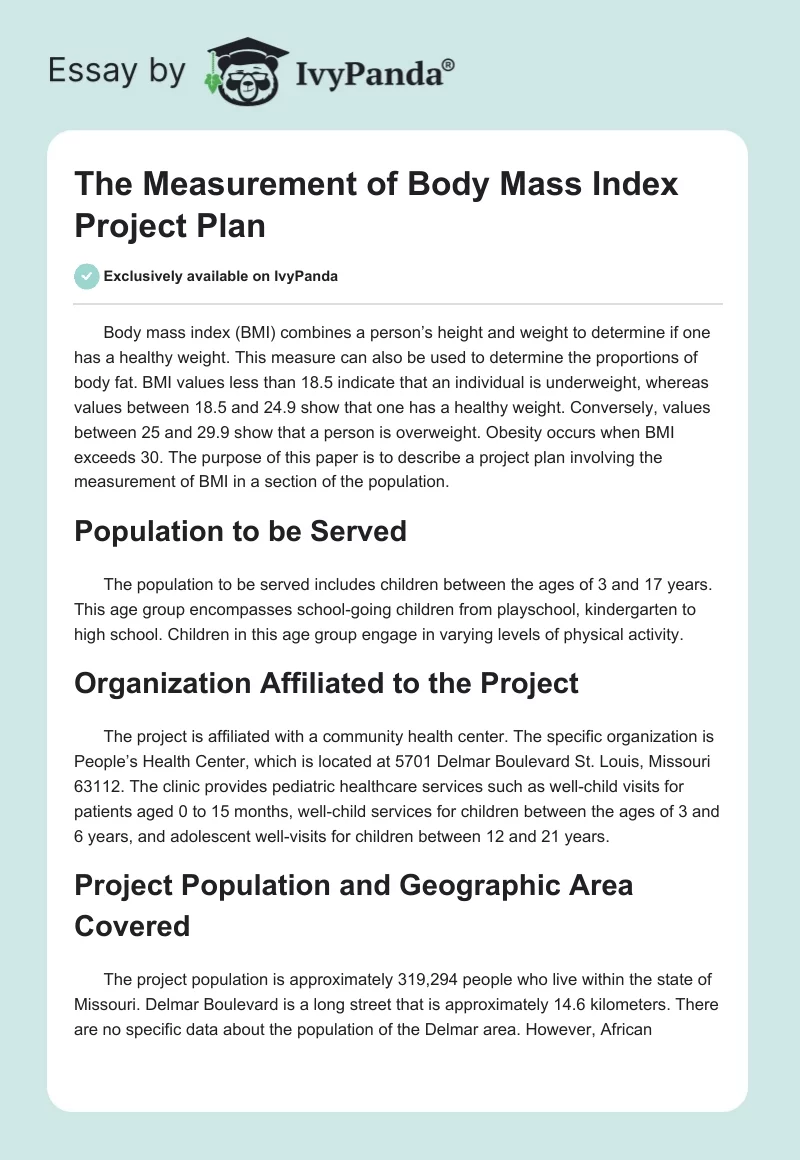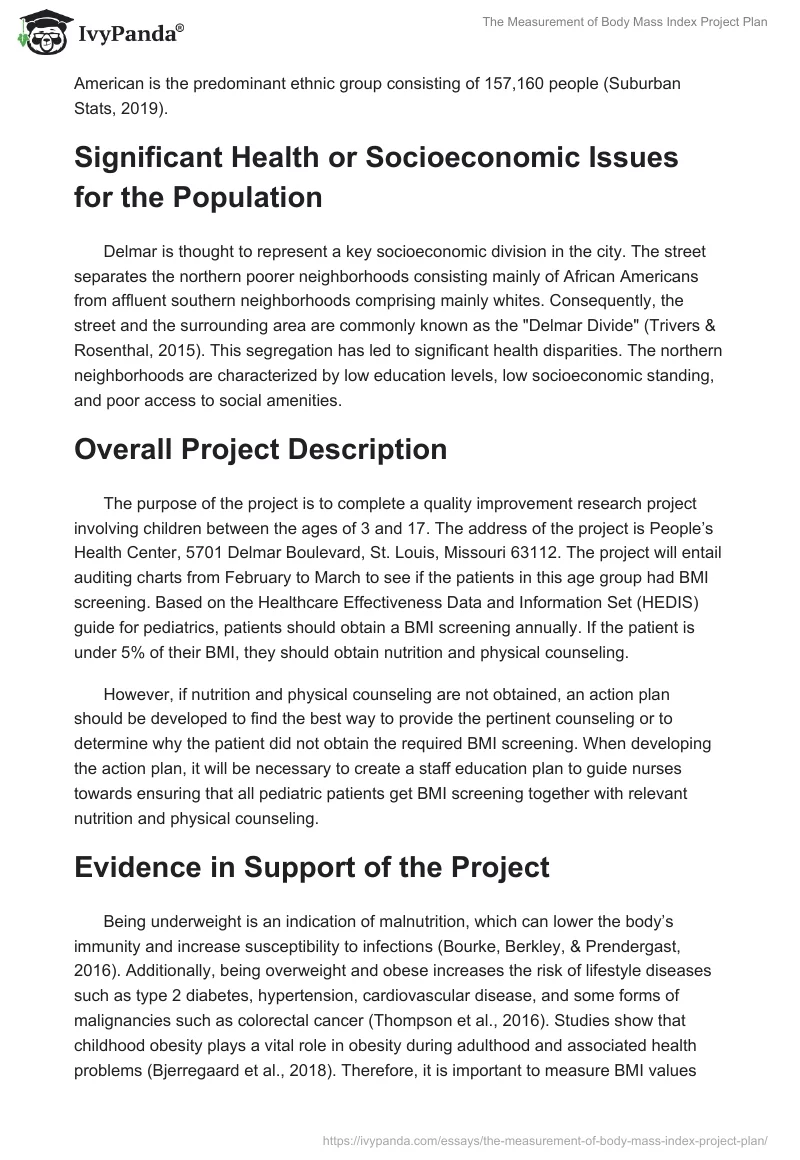Body mass index (BMI) combines a person’s height and weight to determine if one has a healthy weight. This measure can also be used to determine the proportions of body fat. BMI values less than 18.5 indicate that an individual is underweight, whereas values between 18.5 and 24.9 show that one has a healthy weight. Conversely, values between 25 and 29.9 show that a person is overweight. Obesity occurs when BMI exceeds 30. The purpose of this paper is to describe a project plan involving the measurement of BMI in a section of the population.
Population to be Served
The population to be served includes children between the ages of 3 and 17 years. This age group encompasses school-going children from playschool, kindergarten to high school. Children in this age group engage in varying levels of physical activity.
Organization Affiliated to the Project
The project is affiliated with a community health center. The specific organization is People’s Health Center, which is located at 5701 Delmar Boulevard St. Louis, Missouri 63112. The clinic provides pediatric healthcare services such as well-child visits for patients aged 0 to 15 months, well-child services for children between the ages of 3 and 6 years, and adolescent well-visits for children between 12 and 21 years.
Project Population and Geographic Area Covered
The project population is approximately 319,294 people who live within the state of Missouri. Delmar Boulevard is a long street that is approximately 14.6 kilometers. There are no specific data about the population of the Delmar area. However, African American is the predominant ethnic group consisting of 157,160 people (Suburban Stats, 2019).
Significant Health or Socioeconomic Issues for the Population
Delmar is thought to represent a key socioeconomic division in the city. The street separates the northern poorer neighborhoods consisting mainly of African Americans from affluent southern neighborhoods comprising mainly whites. Consequently, the street and the surrounding area are commonly known as the “Delmar Divide” (Trivers & Rosenthal, 2015). This segregation has led to significant health disparities. The northern neighborhoods are characterized by low education levels, low socioeconomic standing, and poor access to social amenities.
Overall Project Description
The purpose of the project is to complete a quality improvement research project involving children between the ages of 3 and 17. The address of the project is People’s Health Center, 5701 Delmar Boulevard, St. Louis, Missouri 63112. The project will entail auditing charts from February to March to see if the patients in this age group had BMI screening. Based on the Healthcare Effectiveness Data and Information Set (HEDIS) guide for pediatrics, patients should obtain a BMI screening annually. If the patient is under 5% of their BMI, they should obtain nutrition and physical counseling.
However, if nutrition and physical counseling are not obtained, an action plan should be developed to find the best way to provide the pertinent counseling or to determine why the patient did not obtain the required BMI screening. When developing the action plan, it will be necessary to create a staff education plan to guide nurses towards ensuring that all pediatric patients get BMI screening together with relevant nutrition and physical counseling.
Evidence in Support of the Project
Being underweight is an indication of malnutrition, which can lower the body’s immunity and increase susceptibility to infections (Bourke, Berkley, & Prendergast, 2016). Additionally, being overweight and obese increases the risk of lifestyle diseases such as type 2 diabetes, hypertension, cardiovascular disease, and some forms of malignancies such as colorectal cancer (Thompson et al., 2016). Studies show that childhood obesity plays a vital role in obesity during adulthood and associated health problems (Bjerregaard et al., 2018). Therefore, it is important to measure BMI values from time to time to provide appropriate nutritional advice and avoid the consequences of unhealthy body weight.
The Rationale for Choosing the Project
The project was chosen by Mrs. Wade, my preceptor. This project was also requested by the clinic because they are expected to obtain BMI values annually for each pediatric patient and provide the correct form of counseling (nutritional or physical exercise) based on the findings. This requirement is part of the HEDIS performance measure for healthcare organizations.
Project Goals
The goal of the project is to raise awareness about childhood obesity and its impact on the community. A second objective of the project is to improve the efficiency of healthcare providers in screening pediatric patients for obesity and malnutrition through an action plan that includes a staff education program. A third goal is to promote a healthy pediatric population in the community by ensuring that underweight and overweight children receive appropriate information to guide them towards healthy body weights.
Measurable Objectives
Measurable objectives that will contribute towards attaining the project goals include conducting chart audits to determine whether the physician or healthcare provider has obtained the patient’s BMI in the past year. Through the audits, it will also be possible to ascertain whether the healthcare worker provided the relevant nutritional and physical counseling following the BMI screening. These audits will be done within the clinic in the initial stages of the project.
Conclusion
Childhood obesity is a significant public health problem. If not addressed in the early stages, it persists into adulthood and leads to preventable health problems such as type 2 diabetes and cardiovascular disease. Therefore, it is important to ensure that children have healthy body weights by monitoring their BMI.
References
Bjerregaard, L. G., Jensen, B. W., Ängquist, L., Osler, M., Sørensen, T. I., & Baker, J. L. (2018). Change in overweight from childhood to early adulthood and risk of type 2 diabetes. New England Journal of Medicine, 378(14), 1302-1312.
Bourke, C. D., Berkley, J. A., & Prendergast, A. J. (2016). Immune dysfunction as a cause and consequence of malnutrition. Trends in Immunology, 37(6), 386-398.
Suburban Stats. (2019). Current St Louis, Missouri population, demographics, and stats in 2019, 2018. Web.
Thompson, N., Mansfield, B., Stringer, M., Stewart, B., Potter, J., & Fernengel, K. (2016). An evidence‐based resource for the management of comorbidities associated with childhood overweight and obesity. Journal of the American Association of Nurse Practitioners, 28(10), 559-570.
Trivers, I., & Rosenthal, J. (2015). A picture is worth 930 words: The Delmar Divide. Focus on Geography, 58(4), 199-200.


